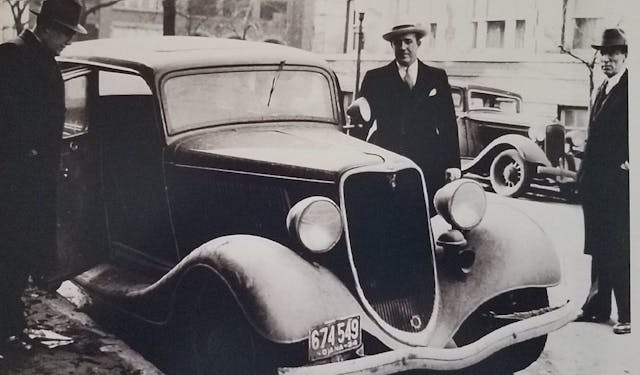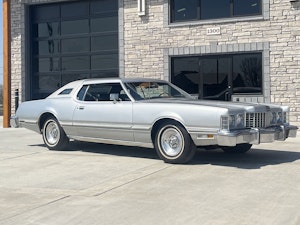Media | Articles
Tracked Down: Dillinger’s 1933 Ford V-8 getaway cop car

If she were alive today, Lake County (Indiana) Sheriff Lillian Holley would no doubt be upset knowing that she and her stolen 1933 Ford V-8 have made their way back into headlines after 87 years. On March 3, 1934, Holley’s vehicle was used as a getaway car by notorious gangster John Dillinger after he broke out of a supposedly “escape proof” jail in Crown Point, Indiana, by bluffing guards into believing a whittled wooden gun was the real thing.
Dillinger fled to Chicago, and after some close calls with FBI agents in the months that followed, he was gunned down outside a movie theater on July 22, 1934.
The long-thought-lost Dillinger getaway car, found in Maine by Dillinger historian Mark Love and recently unveiled to the public, will be a special guest at this weekend’s annual John Dillinger Raid in Warsaw, Indiana, where the gangster and his violent gang committed one of their many robberies. The festival will be held September 11–12.

During an eight-month period that began in September 1933, the Dillinger Gang killed 10 men and wounded seven others while robbing banks and police arsenals throughout the Midwest. Dillinger managed to break out of jail three times; his last escape was from the county jail in Crown Point, where he was sequestered while awaiting trial for the murder of an East Chicago police officer. After the jail break, Dillinger swiped Holley’s ’33 Ford to get to Chicago. By crossing state lines in a stolen vehicle, he violated the National Motor Vehicle Theft Act and put the FBI hot on his tail.
According to the Chicago Tribune, those who knew Sheriff Holley say she was so disgusted by Dillinger that she didn’t want his name spoken in her presence. Holley, who took over after her sheriff husband died in office, was exonerated of any blame in the jail break. She passed away in 1994 at the age of 103.
Marketplace
Buy and sell classics with confidence
Now, the discovery of Holley’s ’33 Ford has put the Dillinger story back in the public eye.

Love’s father co-owned a collection of Dillinger artifacts, and he too is fascinated by the crime story, particularly the stolen Holley car. He searched for it for years, fearing it had been scrapped and that he was chasing a ghost. With the help of a detective, however, he learned that the car’s VIN (256447) had appeared in the database of the Maine Department of Motor Vehicles. That led him to the owner and the car.
The owner told Love that his own father purchased the Ford V-8 at a police auction when they were living in Milwaukee, and he’d brought it to Maine intending to restore it. After the father’s death, his son plated the car for a year before he too lost interest in reviving it.
“Had Mark not discovered it,” says Love’s friend and fellow Dillinger historian Roger Pace, “there was a high probability of it being lost forever.”

Love performed a long-overdue restoration on the Ford, using almost all original parts. The car’s authenticity was never in doubt, since 256447 is stamped in three places on the vehicle and Dillinger’s 1934 wanted poster mentions “he knowingly transported a Ford V-8 four-door sedan, motor number 256447, property of Lillian Holly (sic), Sheriff, Lake County, Indiana from Crown Point to Chicago.”
Among the car’s original attributes are its siren, a shotgun holster mounted on the dash, and even its original wiper blades.
The restored Ford was publicly unveiled at a parade and ceremony in Crown Point in April. The Discovery Channel is working on a documentary.
“It was an act of God that I found it, and I wish my father were alive to see it,” Love told the Tribune. “Today is surreal for me, and he would’ve been very proud.”
Dillinger’s great-nephew Travis Thompson was among those in attendance at the Crown Point event.
“(Dillinger) was the reason I become a police officer,” Thompson says. “I wanted to give the family a different name than what people associated us with.”

Not everyone believes celebrating the escape vehicle is a good thing. Love and Pace, who got to know each other after Pace purchased a 1933 Essex Terraplane from a Dillinger museum, acknowledge the obvious negativity surrounding a murderous criminal who was once regarded as Public Enemy No. 1. But they’re hoping some good can come from it.
Pace says that not only does the Ford draw attention to Holley, who was one the first female sheriffs in the country—perhaps even the first—but it serves as “a monument to all law enforcement organizations across the country whose citizens are grateful for their protection.” And after a permanent home to display the car has been found, Love plans to auction original parts that couldn’t be used in the restoration and donate the proceeds to Concerns of Police Survivors (COPS), a charitable organization devoted to helping families of fallen officers.
“It’s the most historically significant escape car in the country,” Pace says. “Let’s turn that negative into a positive.”












